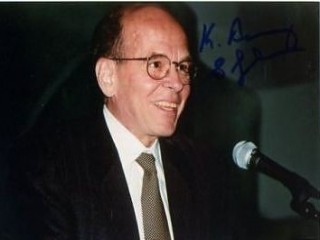
K. Barry Sharpless biography
Date of birth : 1941-04-28
Date of death : -
Birthplace : Philadelphia, Pennsylvania, United States
Nationality : American
Category : Science and Technology
Last modified : 2011-09-16
Credited as : chemist, oxidant reactions, Nobel Prize for Chemistry
2 votes so far
Currently he spends much of his time promoting click chemistry which are selective, exothermic reactions which occur under mild conditions in water; the most successful variant of which is the alkyne-azide (3 + 2) cycloaddition to form 1,2,3-triazoles.
Sharpless was born in Philadelphia. He began his studies in Dartmouth College and earned his PhD from Stanford University in 1963. He continued post-doctoral work at Stanford University and Harvard University.
Sharpless became professor at the Massachusetts Institute of Technology, Stanford University, and the Scripps Research Institute, where he currently holds the W. M. Keck professorship in chemistry.
An interesting personal note, as passed around by graduate students at Scripps Research Institute: Barry is notorious for eating/tasting chemicals that he finds on his students' benches. In fact, he once ate osmium tetroxide while giving a seminar. Osmium tetroxide, while incredibly useful in organic synthesis, has a high vapor pressure and will permanently blind you if the vapors get in your eye. Barry also has only one eye; the other was injured when, an NMR tube exploded in his face while he was observing the work of a graduate student. He is a lab safety advocate at TSRI.
Sharpless is known for asking very long questions at seminars. The seminar might be about transition metal spectroscopy, and he will start a question with, "I had an ear infection once..." This amuses graduate students to no end. On no less than three occasions, he has referenced the act of urination during Q&A sessions after seminars given by distinguished speakers. During the thesis defense of Warren G. Lewis, he commented, "sometimes you just have to reach into the dark and pull out the sexy thing." Also, his keen sense of smell for identifying chemicals is legendary. On occasion this has lead to unexpected results. One particularly humorous story involves Sharpless' trousers being soiled by an irritated urinal co-occupant, upon being told that the pungent odor left no doubt that he had eaten asparagus earlier in the day.
Awards and honors:
ACS Harrison Howe Award 1987
ACS Ira Remsen Award 1989
ACS Arthur C. Cope Award 1992
Tetrahedron Prize for Creativity in Organic Chemistry 1993 (with Ryoji Noyori)
King Faisal International Prize in Science 1995
Guggenheim Fellowship 1987
ACS Roger Adams Medal 1997
ACS Theodore William Richards Medal 1998
ACS Wallace Carothers Award 1999
ORCS Paul N. Rylander Award 2000
SCI Chirality Medal 2000
Benjamin Franklin Medal 2001 (Franklin Institute)
Nobel Prize for Chemistry 2001 (with William S. Knowles and Ryoji Noyori)
John Scott Medal 2001
Wolf Prize in Chemistry 2001 (with Henri B. Kagan and Ryoji Noyori)
American Association for the Advancement of Science 1984
American Academy of Arts and Sciences 1984
Alfred P. Sloan Foundation Fellowship, 1973
Federation of American Scientists Board of Sponsors
Guggenheim Fellowship 1987
National Academy of Sciences 1985
National Institutes of Health Fellowship, 1968
National Science Foundation Fellowship, 1963
















